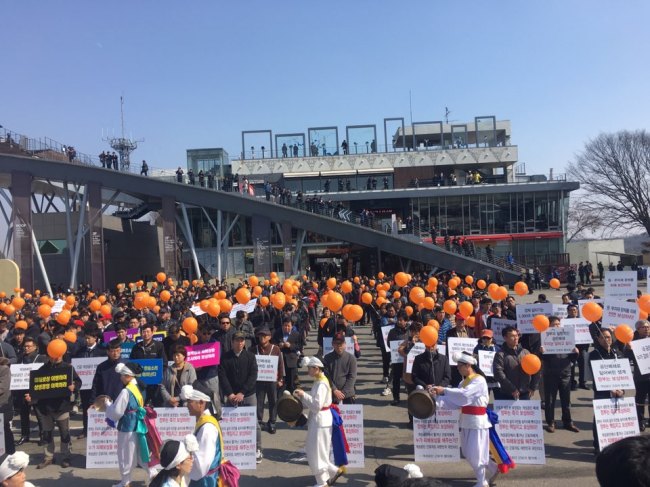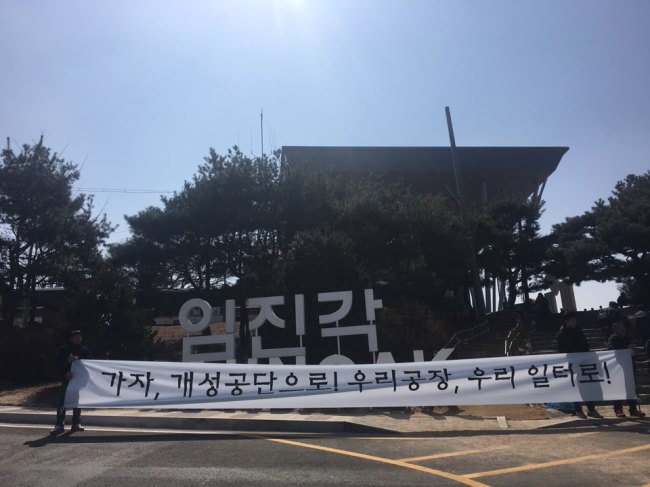[From the scene] Gaesong firms, workers desperate for help
By Ock Hyun-juPublished : March 16, 2016 - 18:45
PAJU, Gyeonggi Province -- A month after the shutdown of Gaeseong industrial park in North Korea’s border city, business owners and employees took to the street on Wednesday, calling for compensation and restarting of operations at the complex.
Led by the emergency council of the Gaeseong-based factory owners and workers, some 1,000 people who lost their jobs overnight gathered at Imjingak Pavilion near the heavily guarded Demilitarized Zone in the afternoon.
At the rally, the participants, consisting of factory owners, subcontractors and workers, called on the government to offer them financial compensation rather than policies such as low-interest loans and tax cuts.
Led by the emergency council of the Gaeseong-based factory owners and workers, some 1,000 people who lost their jobs overnight gathered at Imjingak Pavilion near the heavily guarded Demilitarized Zone in the afternoon.
At the rally, the participants, consisting of factory owners, subcontractors and workers, called on the government to offer them financial compensation rather than policies such as low-interest loans and tax cuts.

“Beyond this point is our Gaeseong complex, but we cannot go there now,” Jeong Gi-seob, cochairman of the emergency council and owner of the clothing company SNG, said. “Our wish is that the government resumes operation of Gaeseong complex.”
“If it cannot happen for the country’s sake, we will not insist on reopening the factory zone,” he said. “But the government should at least financially compensate us to protect our property rights stipulated in the Constitution.”
A public interest group of lawyers has claimed that the decision to shut down the factory had no legal basis and violated property rights. The group demanded the presidential office disclose the legal grounds for the action, but the government refused to reveal it, citing public security.
The protest came amid growing frustration after Seoul shut down the jointly run Gaeseong industrial park on Feb. 10. No consultation was carried out with the firms. The decision was part of a “highly political strategy” in the wake of Pyongyang’s fourth nuclear test and long-range rocket launch, the government said.
Since opening in 2004, the Gaeseong complex, some 60 kilometers northwest of Seoul, housed 123 South Korean firms, and employed around 54,000 North Korean workers in mostly labor-intensive sectors. All remaining South Koreans in the industrial park were expelled by the North early last month, a day after the shutdown.

"I was speechless when I heard about the government’s decision. I could not bring any of my stuff, such as clothes, cosmetics or money from Gaeseong,” said Kang Yong-ja, who has worked as a manger for a clothing factory for two years in the border city.
“We are only workers. What did we do wrong? We had self-esteem as we were working not only to earn money but also contributing to improving inter-Korean relations,” the 52-year-old woman told The Korea Herald. “If the government got us fired, it should have some measures to help us.”
“We need financial support. Without monthly income, I have no way to feed my children and pay for their education right now,” she said, while shedding tears.
According to the council, the closure of the factories caused more than 815 billion won in financial losses, with the actual damage projected to be bigger. Up to 90 percent of workers were dismissed, it said. The government views the estimated losses as inflated.
Last month, the government set up a joint task force team to lay out plans to assist the affected companies and workers. After the fifth round of discussion on Tuesday, the Unification Ministry said it would provide extra subsidies to local firms that ran factories at the industrial park, and welfare benefits for those dismissed.
The measures include low-interest loans for the cash-strapped companies, a cut in interest rates on the South-North Korea Cooperation Fund, and suspension of loan payments. The government will also provide subsidies and consultation for factory owners to set up new facilities in South Korea.
For dismissed workers, the government has said that it will dispatch 94 officials to help the unemployed apply for benefits schemes and find jobs. It will also slash health insurance fees for up to six months, and lend living expenses of up to 1 million won to those who lost jobs.
“The measures are focused on business owners, not on workers,” said Hwang Won-sik, 58, who has been employed at a clothing factory for 10 years. “How do you think it is possible for me to get a job again? It is difficult even for young people to find employment, no?”
The seemingly grim situation has hit subcontractors of Gaeseong-based factories even harder. While the government is busy rolling out plans to support the companies and their workers struck directly by the closure of the factory park, some 5,000 subcontractors and about 124,000 employees have been excluded from the state assistance scheme.
“Our company received orders from one of the factories in Gaeseong, but the shutdown affected our business and I could not receive my wage this month,” said a 60-something man, who wished to remain anonymous. “The government said nothing about how to help us and that’s why I am here.”
The council launched a petition to enact the special law to financially compensate them. Following the rally, the participants marched about 5.1 kilometers from the Imjingak Pavilion to the Unification Bridge in Paju.
The council also plans to request for permission on March 21 to travel to their workplaces in the North, following Pyongyang’s announcement last week that it will liquidate all South Korean assets in the country and nullify all cross-border agreements on economic cooperation.
The government vowed to launch an on-site inspection starting Monday to assess the exact financial damages sustained by local firms and present more detailed financial plans to support them.
By Ock Hyun-ju (laeticia.ock@heraldcorp.com)
“We are only workers. What did we do wrong? We had self-esteem as we were working not only to earn money but also contributing to improving inter-Korean relations,” the 52-year-old woman told The Korea Herald. “If the government got us fired, it should have some measures to help us.”
“We need financial support. Without monthly income, I have no way to feed my children and pay for their education right now,” she said, while shedding tears.
According to the council, the closure of the factories caused more than 815 billion won in financial losses, with the actual damage projected to be bigger. Up to 90 percent of workers were dismissed, it said. The government views the estimated losses as inflated.
Last month, the government set up a joint task force team to lay out plans to assist the affected companies and workers. After the fifth round of discussion on Tuesday, the Unification Ministry said it would provide extra subsidies to local firms that ran factories at the industrial park, and welfare benefits for those dismissed.
The measures include low-interest loans for the cash-strapped companies, a cut in interest rates on the South-North Korea Cooperation Fund, and suspension of loan payments. The government will also provide subsidies and consultation for factory owners to set up new facilities in South Korea.
For dismissed workers, the government has said that it will dispatch 94 officials to help the unemployed apply for benefits schemes and find jobs. It will also slash health insurance fees for up to six months, and lend living expenses of up to 1 million won to those who lost jobs.
“The measures are focused on business owners, not on workers,” said Hwang Won-sik, 58, who has been employed at a clothing factory for 10 years. “How do you think it is possible for me to get a job again? It is difficult even for young people to find employment, no?”
The seemingly grim situation has hit subcontractors of Gaeseong-based factories even harder. While the government is busy rolling out plans to support the companies and their workers struck directly by the closure of the factory park, some 5,000 subcontractors and about 124,000 employees have been excluded from the state assistance scheme.
“Our company received orders from one of the factories in Gaeseong, but the shutdown affected our business and I could not receive my wage this month,” said a 60-something man, who wished to remain anonymous. “The government said nothing about how to help us and that’s why I am here.”
The council launched a petition to enact the special law to financially compensate them. Following the rally, the participants marched about 5.1 kilometers from the Imjingak Pavilion to the Unification Bridge in Paju.
The council also plans to request for permission on March 21 to travel to their workplaces in the North, following Pyongyang’s announcement last week that it will liquidate all South Korean assets in the country and nullify all cross-border agreements on economic cooperation.
The government vowed to launch an on-site inspection starting Monday to assess the exact financial damages sustained by local firms and present more detailed financial plans to support them.
By Ock Hyun-ju (laeticia.ock@heraldcorp.com)
-
Articles by Ock Hyun-ju





![[Herald Interview] 'Amid aging population, Korea to invite more young professionals from overseas'](http://res.heraldm.com/phpwas/restmb_idxmake.php?idx=644&simg=/content/image/2024/04/24/20240424050844_0.jpg&u=20240424200058)


![[Pressure points] Leggings in public: Fashion statement or social faux pas?](http://res.heraldm.com/phpwas/restmb_idxmake.php?idx=644&simg=/content/image/2024/04/23/20240423050669_0.jpg&u=)











